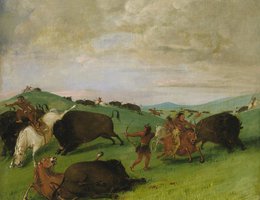

Plains Indians exhibited great skill and ingenuity in turning the natural materials they found around them into tools and materials to help them survive. They used stones, bones, shells, clay, hides, hair, and wood to make tools and implements. But, one of their greatest natural resources was the bison.
The Native Americans of eastern Nebraska in the late 1600s and early 1700s developed a system of seasonal travel carefully planned to put them at the right place at the right time to make the best use of the right resource. Between planting in the spring and harvesting in the fall, the tribes left their permanent villages to hunt game, particularly bison.
![Sioux Encamped on the Upper Missouri, Dressing Buffalo Meat and Robes [Detail] (1832) by George Catlin](/assets/images/45992.2e16d0ba.fill-260x200-c100.jpg)
For most tribes here, their lives centered around the bison hunt.
Each bison provided the tribes with a wealth of different raw materials above and beyond the meat. A bison bull in good condition might weigh more than 2,000 pounds and provide about 800 pounds of useable meat. Cows weighed from 700 to 1,200 pounds, and provided an average of 400 pounds of meat. Horns were fashioned into spoons or scoops. The extra thick hide on the top of the head became a bowl. The heart was used as a sack to carry dried meat. The furry hide was tanned and used by the tribe as the walls of their tepees. Later, these hides became a thriving trade item for them. Even the stomach could be used as a cooking vessel. The stomach would be filled with water, meat, herbs and wild onions. Then hot rocks were placed into the mixture to bring it to a boil. A little later, the tribe had stew.
Although each tribe had slightly different techniques, hunters had two basic ways to hunt the bison. A large party of Indians would often surround a herd and then attack, trying to keep the herd milling yet prevent it from stampeding. Large numbers could be killed using this method. A less efficient and more dangerous method was to run the herd and attempt to kill as many as possible on horseback while the animals fled.
Until the introduction of the repeating rifles in the late 1860s, the use of the bow and arrow was the preferred weapon for communal hunts. If hunts were organized so that each man hunted for his own family, his kills could be identified by the markings on his arrows. Selected hunters were assigned the task of hunting for the poor or those families that did not have an active hunter. Even after French traders began to introduced muzzle-loading muskets as a trade good, the bow and arrow was still used. It was almost impossible to ride a galloping horse and reload a muzzle-loading gun.

Following successful hunts there were days of feasting and hard work. The usual butchering process involved men placing the bison on its belly and removing the hide in two sections, divided along the backbone. Then, the meat had to be cut into long thin sheets and dried in the sun. The dried meat was light, portable, and well preserved.
Working or "dressing" an animal hide was a strenuous job. A woman spent several days preparing the bison hide for use, and the process changed little over the years. First the wet hide was stretched taut and pegged to the ground. The woman then took all the flesh off the hide with a straight, toothed tool known as a flesher. Then, they shaved it to a uniform thickness with an "L" shaped antler or wood scraper. Hides with the hair still on them were used as blankets or coats. If the hair was to be removed, the hide was laced tight in a vertical frame and the hair shaved off with the scraper. The woman then applied a pate of cooked brains that softened the hide. Finally the hide was pulled, twisted, rubbed, and wrung out until it was absolutely dry. At this point the robe was snow white and very soft.
For most of their history, bison were killed by the tribes for their needs. But as trade with Europeans became more important, they began killing bison and took only their hides and tongues to exchange for trade goods. By the 1840s, the number of hides prepared for trade was far greater than those used by the Indians themselves. One estimate is that Native Americans were eating only four out of every 100 bison they killed. In 1839, the American Fur Company bought 45,000 buffalo robes and 67,000 the next year, representing a staggering amount of labor by Indian hide workers.